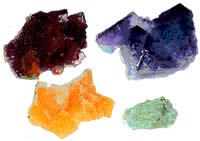Difference between Rocks and Minerals
Key Difference: Rocks are formed from minerals or mineroids solidified into one. A rock could be made up of either one or more than one minerals combined together. Minerals are homogenous solids that have regular structures and are found in rocks, ore and mineral deposits in the earth’s crust.
Almost everyone knows that minerals and rocks are two different things; however people cannot list the differences. It’s in there somewhere and we know it but we can’t still tell them apart. This article seeks to make the differences much easier to remember.

Rocks are formed from minerals or mineroids solidified into one. A rock could be made up of either one or more than one minerals combined together. For example, the most common rock granite is a combination of quartz, feldspar and biotite minerals. The Earth’s crust is also known as a rock. Rocks are classified based upon various characteristics such as mineral and chemical composition, texture and permeability. The main distinguish is based on the process by which they are formed. The lifecycle of a rock is known as the rock cycle, which tries to determine the formation and transformation of the rock. There are three different types of rocks: igneous, sedimentary, and metamorphic.
Ingenious rocks form from the cooling and solidification of molten lava. They can form with or without crystallization and can be further divided into plutonic or volcanic rocks. Sedimentary rocks are formed by the deposition of material within bodies of water or at the Earth's surface. The mineral sediments settle and accumulate over a period of time finally solidifying and forming a bigger piece. Metamorphic rocks are rocks that change from one rock into another by metamorphism. Certain rocks, when they are subjected to heat and pressure, can change forms and alter physically or chemically. Rocks have played a massive part in human development. They were originally used as tools in the ancient times and are now used massively in construction. They are also mined for mineral deposits that are inside them.
 Minerals are homogenous solids that have regular structures and are found in rocks, ore and mineral deposits in the Earth’s crust. Minerals occur naturally and are formed through various geological processes. Minerals are solid and stable at room temperature, can be represented by a chemical formula, are usually abiogenic and have an ordered atomic structure. By definition in order for a sample to be classified as a mineral it should fulfill the following, the substance should be naturally occurring, stable at room temperature, represented by a chemical formula, abiogenic and have an ordered atomic arrangement, though the last two characteristics are highly debated by scientists. The study of minerals is known as mineralogy.
Minerals are homogenous solids that have regular structures and are found in rocks, ore and mineral deposits in the Earth’s crust. Minerals occur naturally and are formed through various geological processes. Minerals are solid and stable at room temperature, can be represented by a chemical formula, are usually abiogenic and have an ordered atomic structure. By definition in order for a sample to be classified as a mineral it should fulfill the following, the substance should be naturally occurring, stable at room temperature, represented by a chemical formula, abiogenic and have an ordered atomic arrangement, though the last two characteristics are highly debated by scientists. The study of minerals is known as mineralogy.
Minerals can be divided in two categories; silicates and non-silicates. Silicate minerals are substances that have the base of unit of a silicate mineral is the [SiO4]4- tetrahedron. Non-silicate minerals are further divided into several other classes by their dominant chemistry, which included native elements, sulfides, halides, oxides and hydroxides, carbonates and nitrates, borates, sulfates, phosphates, and organic compounds. Non-silicate minerals are rarer compared to the silicate ones. A large number of minerals can be distinguished by characteristics such as crystal structure and habit, hardness, luster, diaphaneity, color, streak, tenacity, cleavage, fracture, parting, and specific gravity. The hardness of a mineral is measured on a scale of 1-10 using a Mohs scale, where diamonds rate as 10, while talc rate as 1. Minerals are used most commonly in day to day lives and are also a significant for a country’s economy. Natural resources such as oil and petroleum are also certain types of minerals.
|
|
Rocks |
Mineral |
|
Definition |
Rocks are naturally occurring, solid combination formed from one or many minerals of mineraloids. |
Minerals are substances that are naturally occurring, stable at room temperature, represented by a chemical formula, usually abiogenic and ordered atomic arrangement |
|
Composition |
Rocks are made up of one or more minerals or mineraloids. |
Have a definite chemical composition; minerals are inorganic compounds. |
|
Characteristics |
Rocks are characterized by mineral and chemical composition, texture and permeability. |
Structure and habit, hardness, luster, diaphaneity, color, streak, tenacity, cleavage, fracture, parting, and specific gravity |
|
Classification |
Ingenious, sedimentary and metamorphic. |
Silicates and non-silicates |
|
Study |
Geology |
Mineralogy |
|
Color |
Comes in various colors (red, grey, brown, steel) depending on composition. |
Comes in various colors depending on composition |
|
Price |
Rocks can be found almost everywhere and they are free. |
Price differs depending on rarity of the mineral |
|
Uses |
Rocks are used in various construction applications, weapons (olden times) and are mined for their minerals. |
Bodily functions, help in bone and tooth formation, blood coagulation, muscle contraction |
|
Examples |
Granite, limestone, conglomerate, sandstone, etc. |
Gold, silver, fluoride, quartz, mica, feldspar, etc. |
Image Courtesy: library.thinkquest.org, isgs.illinois.edu









Add new comment